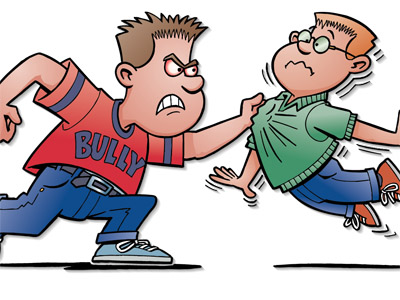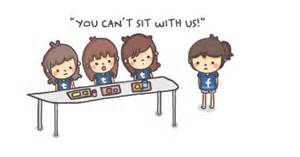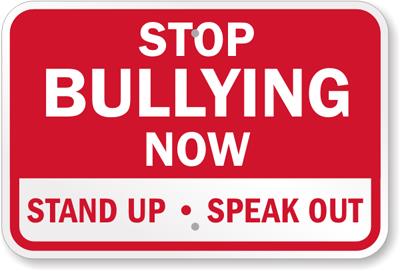Definition
There is no standardised definition.
Bully is a repeatitive, aggressive behavior intended to hurt another individual physically, mentally or emotionally. It is characterized by:
- Hostile intent,
- Imbalance of power and
- Repetition over a period of time.
Types
Bullying can be classified into four types.
Physical, verbal, and relational bullying are most prevalent in primary school and cyber-bullying is more common in secondary school than in primary school.
- Physical

This is any bullying that involved hitting, kicking, or pushing; stealing, hiding, or ruining others’ belongings, or making someone do things against his or her will. The victim may get taunted, tortured, and beaten-up by their classmates. Physical bullying must be stopped quickly as sometimes it ends up in tragic situation.
- Verbal

This is any bullying that is conducted by speaking such as teasing or insulting, spreading rumors, threatening somebody, and making fun of others. This is the most common types of bullying and the main weapon is their voice.
- Relational

This is any bullying that is done with the intent to make someone feel left out or rejected such as by refusal to talk to someone; or encouraging others to bully in some way. Relational Bullying is common amongst youth, particularly upon girls. Unlike physical bullying which is obvious, relational bullying is not overt and can continue for a long time without being noticed.
- Cyber-bullying

Cyber bullying is the use of technology suah as email, instant messaging, social networking sites (such as Facebook), text messages, and cell phones to harass, threaten, embarrass, or target another person. It can have legal consequences and involve jail time if it meets the definition of cyber-harassment or cyberstalking.
Consequences of bullying
Bullying can affect physical and emotional health, both in the short term and later in life.
Research has shown that bullying victims are more likely to:
- Be depressed, lonely, anxious;
- Have low self-esteem;
- Experience headaches, stomachaches, tiredness, and poor eating;
- Be absent from school, dislike school, and have poorer school performance; and
- Think about suicide or try to commit suicide.
Research studies also shown that anyone involved with bullying either those who bully others or those who are bullied are at increased risk for depression.
How to avoid bullying

What can I do to stop bullying?
- Refuse to be an audience for a bully
- Do not follow a crowd
- Do not laugh while someone is being picked on
- Do not participate in gossip
- Do not use the internet to hurt someone
- Walk away and go get help
- Know your own personal strength
Tips to avoid being bullied
- Be confident
- Bullies target kids who are weak and will not fight back
- Bullies will only repeat picking on someone if they think they can get away with it
- Do not show the bully that your feelings are hurt
- Of course it hurts, but bullies gain satisfaction in knowing they hurt someone’s feeling
- Try to ignore a bully
- If you cannot ignore, agree with them (the bully won’t get satisfaction if you agree with them)
- It is not your fault and no one deserves to be bullied
- Make light and add humour to what the bullying says
- Change the subject to redirect the bully’s focus
References
- https://en.wikipedia.org/wiki/Bullying”>https://en.wikipedia.org/wiki/Bullying
- http://home.allergicchild.com/food-allergy-bullying-whats-the-solution/”>http://home.allergicchild.com/food-allergy-bullying-whats-the-solution/
- http://bright-side.org/wellbeing-blog/parents/relational-aggression-girl-bullying/”>http://bright-side.org/wellbeing-blog/parents/relational-aggression-girl-bullying/
- https://www.slideshare.net/jacintaroybal7/bullying2-awarenesspostsubmissionfacebook”>https://www.slideshare.net/jacintaroybal7/bullying2-awarenesspostsubmissionfacebook
- https://www.nichd.nih.gov/health/topics/bullying/conditioninfo/Pages/health.aspx”>https://www.nichd.nih.gov/health/topics/bullying/conditioninfo/Pages/health.aspx
- Eunice Kennedy Shriver National Institute of Child Health and Human Development. (2010)
- Taking a stand against bullying. Retrieved June 17, 2016, from https://www.nichd.nih.gov/news/resources/spotlight/Pages/092110-taking-stand-against-bullying.aspx”>http://www.nichd.nih.gov/news/resources/spotlight/Pages/092110-taking-stand-against-bullying.aspx https://www.nichd.nih.gov/health/topics/bullying/conditioninfo/Pages/health.aspx#top”>[top]
| Last Reviewed | : | 05 Oktober 2017 |
| Writer | : | Dr. Rozimah bt. Abdul Latif |
| Accreditor | : | Dr. Norizzaty Bukhary Bt. Ismail Bukhary |







